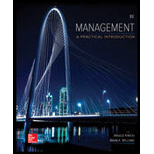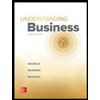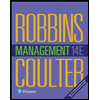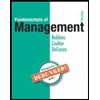
To determine:
The importance of communication and information in the delegation process is determined.
Introduction:
Team responsibilities are evenly distributed to every team members in delegation process depending on the team’s communication and information.
Answer to Problem 1UTC
Solution:
The right information communicated at the right time, improves the Delegation process efficiently.
Given information:
Work environments that are not peaceful make communication inside the team very difficult which in turn hinders the plan of action. So communication with proper information is required.
Explanation of Solution
A problematic working environment needs a proper delegation process to execute the plan of action. Training is given for the working team members to show their full attention accounting for the healthcare. Such method helps in governing this process. Hence sharing the most important information rather than sharing all the information becomes critical. So the teams are trained for it and hence deciding the plan of action.
The delegation process in a work environment is carried out with good communications along with proper information by training the team members.
Want to see more full solutions like this?
Chapter 15 Solutions
Management Looseleaf
- Capsim Team PowerPoint Presentations - Slide Title: Major Decision PointWhat were your major decision points with Broad Differentiation, R&D, Marketing, Awareness, and Accessibility strategies on Capsim?arrow_forwardFor PurrTech’s expansion into Germany, I’ve decided to use a polycentric staffing approach—meaning we’ll hire German professionals to run our operations there. I believe this is the most respectful and effective choice. After all, no one knows how to do business in Germany better than those who live and work there. I want to build something that fits the local culture, not just transplant our way of doing things. Germany is home to a highly skilled and well-educated workforce, especially in technical fields. Their strong focus on vocational training and quality makes this a great opportunity to learn and grow alongside our team there. By working with local talent, we can adapt our products and operations to meet the expectations of German consumers and regulators without missing a beat. When it comes to hiring for leadership roles, my top priority is finding people who combine a solid understanding of local laws and regulations with a forward-thinking, solution-focused mindset. I’m…arrow_forwardWhat is a good response to this post? The cultural nuances and education levels in Italy for our new operations, a hybrid staffing approach leaning towards a regiocentric model is most strategic. While initially, a few key global-strategy-aligned individuals might be placed in top leadership an ethnocentric element the primary focus will be on recruiting Italian talent for managerial, administrative, and plant worker roles. Italian managers bring invaluable local market understanding and cultural intelligence crucial for navigating business practices and building relationships. A well-educated local workforce is available for administrative tasks, ensuring smooth daily operations. For plant workers, local hiring is practical and fosters community goodwill. However, my paramount hiring requirement across all levels is adaptability, a growth mindset, and particularly, cultural intelligence. Success in Italy demands individuals who can not only perform their duties but also navigate the…arrow_forward
- What is a good response to this post? A hybrid staffing approach would be the most effective for Nike's expansion into China. This approach allows for Nike to place local professionals in China in key roles, which respect local customs, cultural norms and consumer preferences. Also, it ensures Nike maintains its global standards, innovation mindset and unified brand culture across markets. When selecting staff for the expansion I would recommend the top requirement to be adaptability and a growth mindset. While technical knowledge and experience is important, the ability to adjust to change, work across cultural boundaries, and have continuous learning is vital in the fast-evolving environment. Having this mindset supports long-term success, fosters innovation, and helps employees navigate challenges naturally.arrow_forwardWhat is a good response to this post? Formal leaders play a critical role in the successful implementation of strategy within an organization. Their authority allows them to make key decisions, allocate necessary resources, and hold individuals accountable for performance. This clear decision-making power and influence can foster alignment across teams, facilitate collaboration, and ensure the strategy’s goals are prioritized. Additionally, their position lends them legitimacy and the ability to inspire others, motivating staff to embrace and execute the plan. With ownership over resources, formal leaders are well-equipped to ensure the necessary infrastructure is in place, and their accountability often drives a strong commitment to achieving success. However, being a formal leader in strategy implementation also presents challenges. Leaders can become overwhelmed by the sheer responsibility of managing both high-level strategy and daily operations, leading to burnout or decision…arrow_forwardCreate an expanded outline for InnovateTech an AI powered healthcare platform to the North American market. Use the bold headings listed below as organizational headers for the main sections of the policy manual. Outline three to five short, relevant commentary sentences supported by any necessary citations. This is an opportunity to organize your ideas for your company and to integrate citations from required sources. Strategy Formation Describe InnovateTech. Comment 1 Comment 2 Comment 3 Describe the value chain analysis of InnovateTech. Description of the strategic initiative (goals to be achieved). Strategy Execution–Policies Potential for process re-engineering to achieve the goal more efficiently. Resource allocation policies to support the initiative’s implementation. Human resource management policies to support the initiative’s implementation. Human resource policies to empower people in supporting organizational success. Incentive policies to support the…arrow_forward
- Create an expanded outline for InnovateTech an AI powered healthcare platform to the North American market. Use the bold headings listed below as organizational headers for the main sections of the policy manual. Outline three to five short, relevant commentary sentences supported by any necessary citations. This is an opportunity to organize your ideas for your company and to integrate citations from required sources. Strategy Formation Description of InnovateTech. Example: Comment 1 (citation, if needed). Example: Comment 2 (citation, if needed). Example: Comment 3 (citation, if needed). Value chain analysis of InnovateTech. Description of the strategic initiative (goals to be achieved). Strategy Execution–Policies Potential for process re-engineering to achieve the goal more efficiently. Resource allocation policies to support the initiative’s implementation. Human resource management policies to support the initiative’s implementation. Human resource policies to empower…arrow_forwardCreate an expanded outline for InnovateTech an AI powered healthcare platform to the North American market. Use the bold headings listed below as organizational headers for the main sections of the policy manual. Outline three to five short, relevant commentary sentences supported by any necessary citations. This is an opportunity to organize your ideas for your company and to integrate citations from required sources. Strategy Formation Description of InnovateTech. Example: Comment 1 (citation, if needed). Example: Comment 2 (citation, if needed). Example: Comment 3 (citation, if needed). Value chain analysis of InnovateTech. Description of the strategic initiative (goals to be achieved). Strategy Execution–Policies Potential for process re-engineering to achieve the goal more efficiently. Resource allocation policies to support the initiative’s implementation. Human resource management policies to support the initiative’s implementation. Human resource policies to empower…arrow_forwardFor this Portfolio Milestone, you will create an expanded outline for InnovateTech an AI powered healthcare platform to the North American market. Use the bold headings listed below as organizational headers for the main sections of the policy manual. These headings do not require additional comment. For each subheading, outline three to five short, relevant commentary sentences supported by any necessary citations. This is an opportunity to organize your ideas for your Portfolio Project and to integrate citations from required sources. The Policy Manual Strategy Formation Description of InnovateTech. Example: Comment 1 (citation, if needed). Example: Comment 2 (citation, if needed). Example: Comment 3 (citation, if needed). Value chain analysis of InnovateTech. Description of the strategic initiative (goals to be achieved). Strategy Execution–Policies Potential for process re-engineering to achieve the goal more efficiently. Resource allocation policies to support the…arrow_forward
- What is a good response to this post? In this week's lecture, one piece that stuck with me is that "informal leaders are only leaders when others recognize them as such...[because] a leader without followers is not a leader" (Module 5 Lecture). When implementing a strategy, I find that there is great success. with execution when leaders get buy-in from informal leaders. Formal leaders "earned their status by developing strong relationships with the people around them and proving themselves, through actions, to be reliable and trustworthy" (Indeed Editorial Team, 2025). Getting teams onboard a strategy will likely yield the best outcome by collaborating often and openly with informal leaders. Without informal leadership buy-in, strategy implementation could be difficult, as these leaders often set the tone for the people within their team. If an informal leader perhaps disagrees with or dislikes a strategy, an informal leader could even negatively influence the team.arrow_forwardDrawing on ABC's experience in expanding into Mauritania, discuss the significance of the Experience Curve and Learning Effects for firms expanding internationally, and analyse their long-term benefits in a competitive global market. Demonstrates a clear and thorough understanding of both the Experience Curve and Learning Effects, with detailed examples related to ABC’s expansion. Applies the concepts effectively to ABC’s expansion into Mauritania, with clear examples of how these effects manifest in the new market. Effectively incorporates relevant theories and models to support the analysis. Response should be well-organised, with clear and logical arguments that flow seamlessly. The language is concise and appropriate.arrow_forwardEntering foreign markets presents firms with various strategic options. Using the case of ABC's expansion into Mauritania, discuss the key factors influencing a firm's choice of market entry strategy. Demonstrates a clear and detailed understanding of market entry strategies, providing a strong evaluation of the factors affecting ABC’s choice of entry strategy in Mauritania. Applies relevant theories and concepts effectively to ABC’s entry into Mauritania, with strong, context specific examples and explanations. Provides a comprehensive evaluation of the key factors affecting market entry, explaining how each factor influences the choice. Response should be well-organised, with clear and logical arguments that flow seamlessly. The language is concise and appropriate.arrow_forward
 Understanding BusinessManagementISBN:9781259929434Author:William NickelsPublisher:McGraw-Hill Education
Understanding BusinessManagementISBN:9781259929434Author:William NickelsPublisher:McGraw-Hill Education Management (14th Edition)ManagementISBN:9780134527604Author:Stephen P. Robbins, Mary A. CoulterPublisher:PEARSON
Management (14th Edition)ManagementISBN:9780134527604Author:Stephen P. Robbins, Mary A. CoulterPublisher:PEARSON Spreadsheet Modeling & Decision Analysis: A Pract...ManagementISBN:9781305947412Author:Cliff RagsdalePublisher:Cengage Learning
Spreadsheet Modeling & Decision Analysis: A Pract...ManagementISBN:9781305947412Author:Cliff RagsdalePublisher:Cengage Learning Management Information Systems: Managing The Digi...ManagementISBN:9780135191798Author:Kenneth C. Laudon, Jane P. LaudonPublisher:PEARSON
Management Information Systems: Managing The Digi...ManagementISBN:9780135191798Author:Kenneth C. Laudon, Jane P. LaudonPublisher:PEARSON Business Essentials (12th Edition) (What's New in...ManagementISBN:9780134728391Author:Ronald J. Ebert, Ricky W. GriffinPublisher:PEARSON
Business Essentials (12th Edition) (What's New in...ManagementISBN:9780134728391Author:Ronald J. Ebert, Ricky W. GriffinPublisher:PEARSON Fundamentals of Management (10th Edition)ManagementISBN:9780134237473Author:Stephen P. Robbins, Mary A. Coulter, David A. De CenzoPublisher:PEARSON
Fundamentals of Management (10th Edition)ManagementISBN:9780134237473Author:Stephen P. Robbins, Mary A. Coulter, David A. De CenzoPublisher:PEARSON





